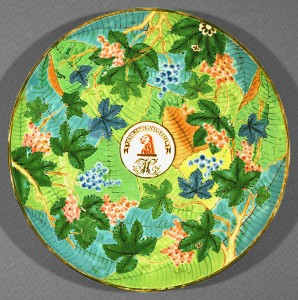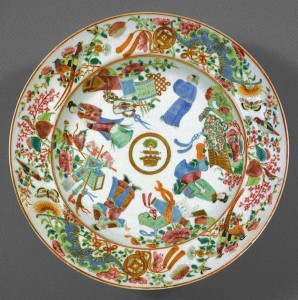British market wares associated with particular owners
Of the special order wares known to have been made for British families or organizations, many—including several objects shown here—bear armorial devices. Others have surviving histories of ownership.
 Plate bearing arms of Boynton quartering Topham, 1762 or 1767+
Plate bearing arms of Boynton quartering Topham, 1762 or 1767+
The service that includes this plate was perhaps created in 1762 to celebrate the marriage of Sir Griffith Boynton, 6th baronet and member of parliament, to Charlotte Topham, the daughter of a judge in York, England. Alternatively, it may have been made after Charlotte’s death (1767) but before Boynton’s second marriage.
Plate bearing motto of Hill Family, about 1810
This plate, bearing an unusual variant of the “tobacco leaf” pattern, is from one of two services with the same crest and decoration. The “H” and “FAC RECTE NIL TIME” (Do right and fear naught) suggest it was made for the Hill family, even though the crest is not known to have been used by the family.

Plate bearing crest of Hussey, 1795–1800
This plate is initialed “JCH” and, like a pair of tureens and stands at Winterthur, most likely is from a special-order service made for the Reverend John Hussey of Kent, England, and his wife, an heiress named Catherine Jennings. Hussey died in India in 1799.
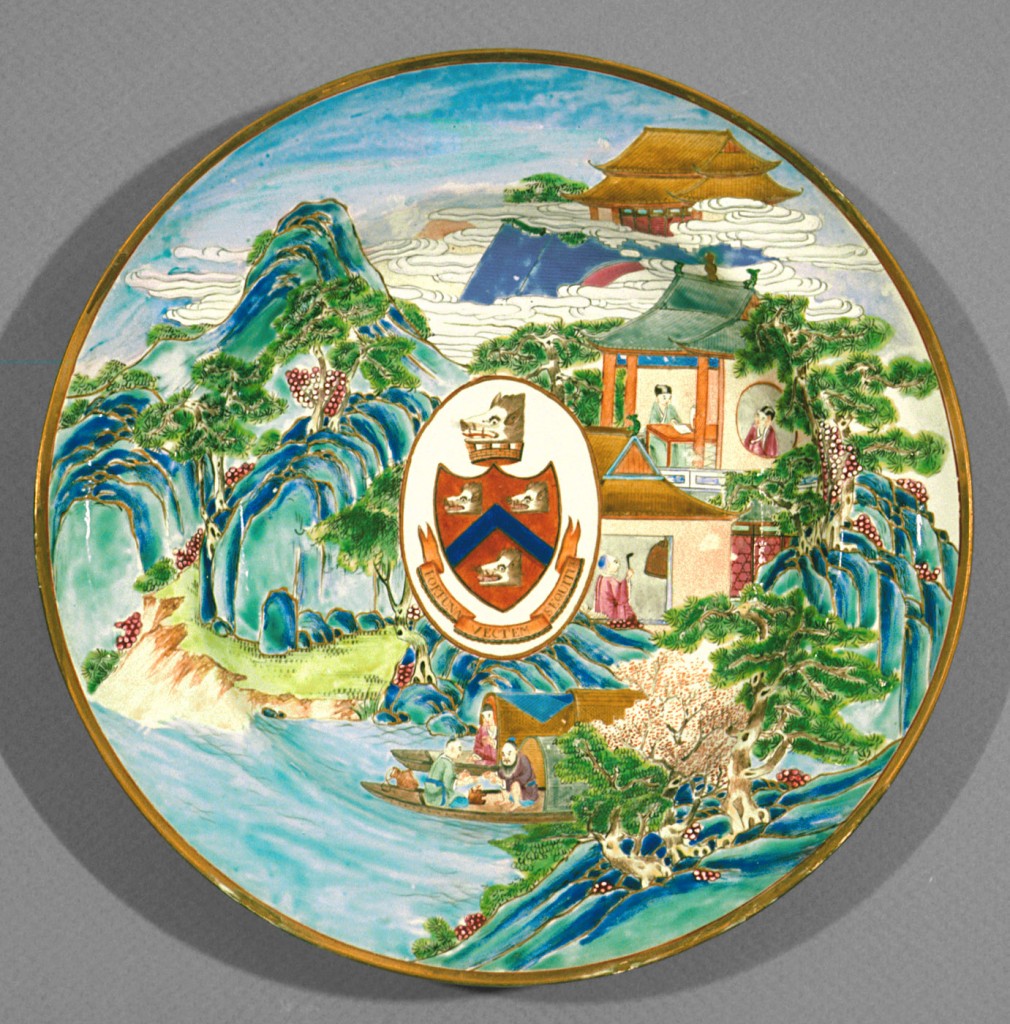 Soup plate bearing arms of Wight, about 1810
Soup plate bearing arms of Wight, about 1810
The motto “Fortuna vectem sequitur” on this plate—from a service where each plate features a different scene—relates to the Wight of Braboeuf Manor family of County Surrey, England. The coat of arms and crest, however, are incorrectly painted with boars’ heads instead of bears’ heads.
Soup plate bearing crest of Hamilton, about 1835
Radiating patterns of Chinese “Auspicious figures” and “Hundred Antiquities” motifs can be found on several British armorial services. This soup plate is thought to be from a service made for Hamilton Charles James Douglas-Hamilton, ambassador to Brazil, and his wife, Susannah Robinson, the daughter of the governor of Tobago.
 Soup plate bearing arms of Grant of that Ilk, 1810–20
Soup plate bearing arms of Grant of that Ilk, 1810–20
This soup plate is from a service made for a member of the Scottish nobility. It may have been ordered for the marriage of Francis William Grant, brother of the Earl of Seafield, to Anne Dunn of Highham House in 1811. The same coat of arms appears with Chinese figures on dinnerware with a floral and butterfly border, indicating that more than one service was ordered by the family.
Dish bearing arms of the Honorable East India Company (HEIC), about 1817
Of four services created for the HEIC (two in underglaze blue), three bear coats of arms based on the company bookplate from the “Secretary’s Office.” This small dish is from the largest of the services and was provided to company officials in India.
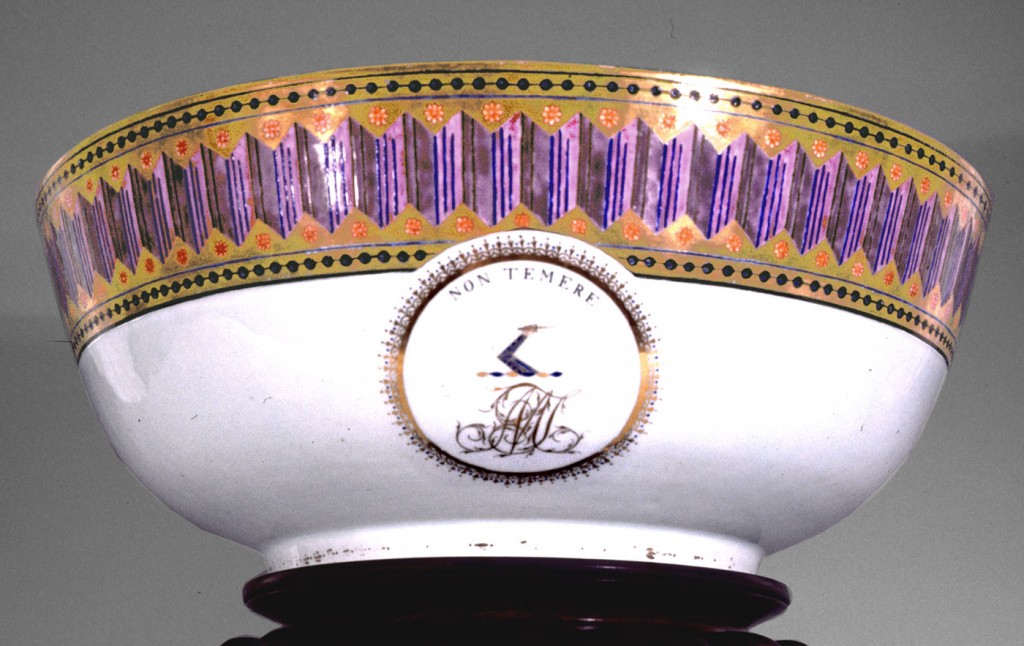 Punch bowl bearing crest of Forbes, about 1810
Punch bowl bearing crest of Forbes, about 1810
Scotsman Charles Forbes was involved in the Honorable East India Company, and in 1823 he was made a baronet, having been a successful merchant in Bombay. The “M. F.” initials on the bowl may refer to Charles’s sister-in-law, Mary Ann Forbes, who married the Reverend George Forbes in 1809.
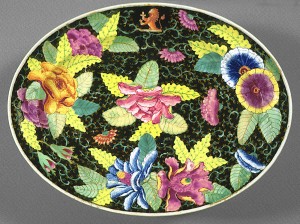 Dish bearing crest of Erskine of Pittodrie, about 1810
Dish bearing crest of Erskine of Pittodrie, about 1810
A recently discovered set of Chinese lacquer boxes containing gaming counters is decorated with a crest like the one on this dish. The crest refers to the arms of the Erskines of Pittodrie, Scotland, or possibly those of the Erskines of Dun in County Forfar.
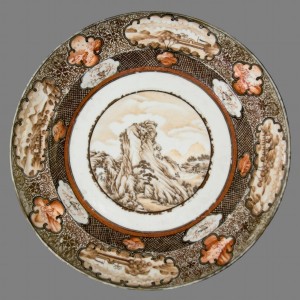
Plate resembling service for Drummond, 1795–1800
The general design on this finely painted “Palaceware” plate has much in common with that on a service ordered by Scotsman James Drummond, later Viscount Strathallan, who served as president of the Select Committee and chief of the English settlement in Canton. The Drummond service features sepia and famille rose enamel Chinese scenes.

